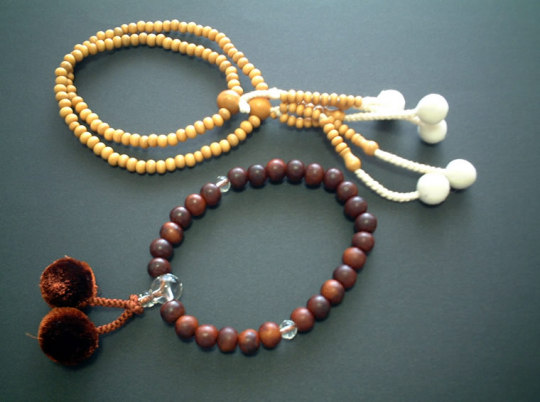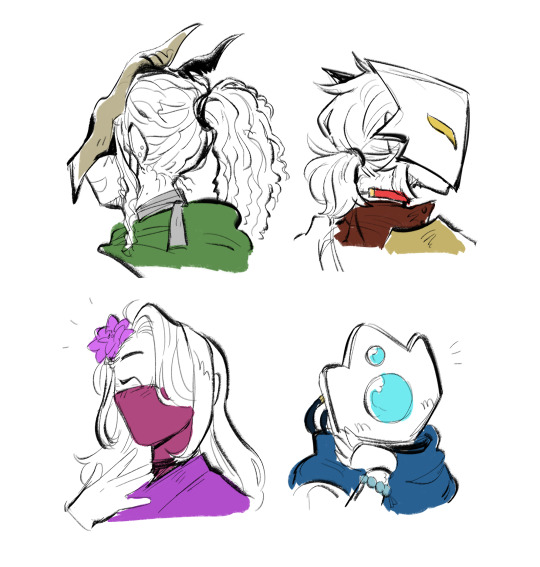#juzu
Explore tagged Tumblr posts
Text

otherworld(ly)
#art#retrofuture#design#collage#aesthetic#pink#gas mask#en no gyōja#jinben daibosatsu#juzu#bumper sticker aesthetic#helvetica
282 notes
·
View notes
Text

Unsual patterns for this black based obi showing buddhist items: osenko (incense stick offering), juzu (Buddhist prayer beads), and hossu (horse tail ceremonial fly whisk).
I wonder who commissionned this obi and why (patterned mourning/ half-mourning obi are not like this usually?).
In any case, here is some buddhist vocabulary for Obon season :)
#japan#fashion#kimono#obi#summer in japan#obon#buddhism#osenko#senkou#incense#incense stick#juzu#prayer beads#hossu#fly whisk#fly chaser#着物#帯
106 notes
·
View notes
Text
JAPANESE BUDDHIST PRAYER BEADS
General
"The Buddhist rosary was introduced to Japan in the early stages of Japanese Buddhism... Although rosaries were probably considered valuable objects since the introduction of Buddhism in Japan, it seems they were not widely used in religious practices for another several centuries. Only by the Kamakura period (1185–1333) do prayer beads seem to have become common ritual implements."
"The form of the first prayer beads in Japan already varied, but over the centuries, the rosary was further modified to fit the usage and doctrine of different schools. As a result, various distinct forms developed, which can be easily distinguished from each other today. The rosaries differ, for example, in the number of larger beads, tassels, or beads on the strings attached to the larger beads... Also, the manner of how to hold a rosary differs depending on the school."
The most common term for the rosary is juzu 数珠 (Ch. shuzhu), literally “counting beads” or “telling beads,” which hints at the ritual usage of the beads for counting recitations. The other common term, nenju 念珠 (Ch. nianzhu), can be understood either as “recitation beads,” describing the beads as an aid in chanting practices, or as “mindfulness beads,” suggesting that “chanting is an aid to meditation and even a form of it.”
(from Prayer beads in Japanese Sōtō Zen, link under Sōtō)

Juzu beads in two different styles. Image from Wikimedia Commons by Suguri_F.
The number of beads
"The earliest text on prayer beads, the Mu huanzi jing, states that the rosary should have 108 beads, which is the most common number of beads in a Buddhist rosary. Other sutras further mention rosaries with 1,080, fifty-four, forty-two, twenty-seven, twenty-one, and fourteen beads. Lower numbers than 108 are encouraged, if one has difficulties obtaining 108 beads. Rosaries with thirty-six or eighteen beads are also used in Japan."
(from Prayer beads in Japanese Sōtō Zen, link under Sōtō)
108: The number 108 has many symbolic associations. Most commonly the 108 beads are associated with the 108 defilements. The number 108 further represents the 108 deities of the diamond realm (kongōkai) in esoteric Buddhism, or the 108 kinds of samādhi.
54: The number fifty-four stands for the fifty four stages of practice consisting of the ten stages of faith, ten abodes, ten practices, ten transferences of merit, ten grounds, and the four wholesome roots.
42: The number forty-two expresses the ten abodes, ten practices, ten transferences of merit, ten grounds, plus the two stages of “equal” and marvelous enlightenment (tōgaku and myōgaku).
27: Twenty-seven symbolizes the stages toward arhatship.
21: The number twenty-one further represents the ten grounds of inherent qualities, plus the ten grounds of the qualities produced by practice, plus buddhahood.
The names of the beads
"A rosary has at least one large bead, which is called the mother bead (boju) or parent bead (oya dama) alerting the user that they have finished one round of the rosary. When finishing one round, the user should not cross over the mother bead, as this would be a major offense; instead, they should reverse the direction."
"Sometimes a rosary has two larger beads; in this case, the second larger bead is either called middle bead (nakadama), as it marks the middle of the rosary, or also mother bead. The other beads on the main string are called retainer beads (ju dama) or children beads (ko dama). There are four beads among the retainer beads that are usually of smaller size and/or different color. They are placed after the seventh and the twenty-first beads on both sides of the (main) mother bead and therefore mark the seventh or twenty-first recitation. These four beads are called shiten 四点 beads (lit. four point beads). They are often interpreted as the four heavenly kings (Shitennō), Jikokuten (Skt. Dhṛtarāṣṭra), Tamonten (also called Bishamonten, Skt. Vaiśravaṇa), Zōjōten (Skt. Virūḍhaka), and Kōmokuten (Skt. Virūpākṣa). The beads are therefore also called “four heavenly kings” (shiten 四天), a homophone of “four points.”
"The main mother bead, and sometimes also the middle bead, has tassels attached. Usually, there are two short strings with smaller beads, known as recorder beads (kishi dama) or disciple beads (deshi dama), attached to the main mother bead. These beads help to count the rounds of recitations. They are thought to symbolize the ten pāramitās or, especially if they are called disciple beads, the Buddha’s direct disciples. At the end of the strings just above the tassels are the recorder bead stoppers, which are called dewdrop beads (tsuyudama), because they are often shaped like teardrops. The string between the mother bead and the recorder beads has usually a small loop, and on one side of this loop is a small bead, which is called jōmyō ���明 (lit. pure and bright)... The bead is also called successor bodhisattva (fusho bosatsu) because it might take the place of any recorder bead that might be broken."
(from Prayer beads in Japanese Sōtō Zen, link under Sōtō)
Prayer beads in different Japanese schools
Jōdō (Pure Land)
Nichiren

A set of garnet Nichiren Shoshu Juzu prayer beads. Image from Wikimedia Commons by BeccaTrans.
Ōbaku
Rinzai

Honren juzu beads used in the Rinzai sect of Zen Buddhism. Image from Wikimedia Commons by Peehyoro Acala.
Shingon
Sōtō
Dōgen, the founder of the Sōtō Zen school, wrote about prayer beads: “You should not hold a rosary in the hall" and later writes that a monk should not disturb others by making a sound with the rosary on the raised platform. Later still, he elaborates “In the study hall, you should not disturb the pure assembly by reading sutras with loud voices or loudly intoning poems. Do not boisterously raise your voice while chanting dharani. It is further discourteous to hold a rosary facing others.”
"Considering these three brief statements in Dōgen’s works, we can presume that the rosary played no significant role for Dōgen and his community. Yet some prayer beads left by early Sōtō monks have been regarded as temple treasures and have been venerated as a contact relic in remembrance of the master. One example is a rosary made of beautiful rock crystal that Keizan used and that is now preserved at the temple Yōkōji in Ishikawa prefecture."
The form of the Sōtō rosary changed over time. Today’s formal Sōtō rosary has 108 beads and two mother beads, one larger one, and a slightly smaller one, as well as the four point beads. It has tassels only on the main mother bead, but there are no beads on the strings attached to this bead. The contemporary formal Sōtō rosary also has a small metal ring, which symbolizes the circle of rebirth in the six realms. In the Rinzai and Ōbaku schools this ring is not part of the rosary and, therefore, a Sōtō rosary can easily be distinguished from rosaries of the other Zen schools. When Sōtō clerics added this metal ring is unclear. ...This metal ring was not part of the Sōtō rosary in the Tokugawa period and therefore must have been added later."
(from Prayer beads in Japanese Sōtō Zen, link below)
⚫️ Sōtō Zen - Wikipedia
⚫️ Prayer Beads in Japanese Sōtō Zen by Michaela Mross (link to download)
⚫️ Memorial service etiquette (sotozen.com)
Tendai
2 notes
·
View notes
Audio
Juzu a.k.a. Moochy meets Motoharu - Untitled Movements - house music producer mixes a jazz sextet led by saxophonist of Soil and “Pimp” Sessions
Sax : Motoharu Sax : Megumi Kitano Violin : Kyoko Oikawa Electronics : Uriah Klapter Percussions : Keita Brasil Bass : Junji Yamaguchi Darbuka : Sait Arat (1, 3, 4) Additional Beatz&Bass : MaL (2, 6) Voices : Children @ Paonta Sahib School (7) (Tibetan Government-in-Exile School in Paonta Sahib, about 480 km north of Delhi, India) Recorded by Tetsuya Sukeyasu on Mar 2005 Tibetan Education Support Foundation Art Work & Design : sati. Recording, Arrangement & Mix : J.A.K.A.M. Mastering : Sinkichi Kadoya Dedicated to Rabindranath Tagore
2 notes
·
View notes
Text

Canon Juzumaru: Master, shall we pray together~?
"Historically Accurate" Juzumaru: Master. Have you recited your daily Namu Myoho Renge Kyo?
#Slanderman will save you from the damnation even if he has to send you to hell for it personally#shitpost#historically accurate juzumaru#slanderman!Juzu#linfamy: nichiren#> mamuzzy draws stuff#juzumaru tsunetsugu#tkrb#touken ranbu
8 notes
·
View notes
Text

📿Source: https://x.com/jayvikism/status/1898538315131003168?t=LPKrEOGX3CQ5ui2AB3BEkA&s=19
#bracelets#jewelry#conventions#viktor va#esotericrecondite#hmasguys#fanboying fangirling#humor#please forgive my use of the juzu beads emoji it was the closest to a bracelet
1 note
·
View note
Text

hehe (id under cut)
[ID: 4 portrait drawings of the four player characters from slay the spire, silent, ironclad, watcher & defect. silent & ironclad are facing away from the viewer with their hair in ponytails. watcher & defect are facing the viewer with a hand by their faces and three little lines by their heads indicating joy. notably each one is wearing a relic from the game as accessories: silent's wearing tough bandages around her neck, ironclad's wearing a velvet choker, watcher has her hair down & a violet lotus on her head & defect is wearing a juzu bracelet. End ID]
771 notes
·
View notes
Text
youtube
ASMR | OC - Lysander (Villain) x Listener SFW Comforting Your Villain After A Nightmare
[TM4A] [Established romantic relationship] [Reverse Comfort]
And with this, the last of the faceless historical OCs has a proper thumbnail. Based on Patreon requests. Trynwise Hollowbark asked "We’ve been comforted by Lysander for nightmares but I don’t think we’ve comforted him for them after he took a blade for us? I would love comforting him after a nightmare about that/losing us/hero again.", YikesItsConnor seconded the request, Angelus asked "Another idea would be reverse nightmare comfort with our villian since he took such good care of us", Juzu asked "I'd love a reverse nightmare comfort with Lucien, Hawthorne or Lysander. I would love that they try to keep it to themselves but have to give into the listeners comfort with lots of cuddles, kisses, love and gratefulness".
(This went up yesterday on Youtube and Patreon, I just forgot to crosspost it here yesterday because I fell asleep)
.
Old public spicy audios on sound gasm (link in pinned post). 2 Exclusive spicy audios on Patreon every month. I also stream on Twitch every week @ dervampireprince . [minors + ageless blogs dni. this blog is for 18+ only.] [do not repost/reupload/edit any of my content]
7 notes
·
View notes
Photo

Amber Buddhist rosary, with color-lacquered container with the motif of tree peony and wild boar. Prayer beads: Nara period/8th century, Container: Kamakura period/13-14 century
Nenju, also called Juzu, is a string of beads or a rosary, generally used in Buddhist services even now. Originally, a certain number of beads (basically 108 beads) were strung on thread and used for counting the chant of repeating the name of Amida (Shômyô) or Darani (magical words). The two strands of Nenju in N-287 and N-288 are considered to be those listed in “Kokin-mokuroku-sh” (the Catalogue of the Ancient and Modern) written by Kenshin in the Kamakura period (1192-1333) and “Onshariden-houmotsu-chûmon” (Order-book of Treasures for Reliquary Hall) collated in Tenmon 19 (1550), as one of the treasures enshrined in a reliquary hall. The Nenju in N-287 and N-288 come with a small lacquered case with a lid (J. Gousu), with the peony and cat patterns in the Kamakura period and a gilded bronze one with the pattern of Chinese milk vetch in the Edo period (1603 - 1868), respectively.
#artifact#Amber Buddhist rosary with color-lacquered container with the motif of tree peony and wild boar
7 notes
·
View notes
Text
SŌTŌ-INSPIRED JUZU IN BAYONG
This is a juzu inspired by the contemporary prayer beads used by the Sōtō-sect, one of the Japanese Zen Buddhist schools (my post about Japanese Buddhist prayer beads). It has 108 counting beads, 4 marker beads in addition to the parent beads (the middle bead, also known as second parent bead, here similar to the markers) and a sliding ring typical of the Sōtō school. I did, however, use a stone ring instead of the metal (usually silver) ring used in the Sōtō juzu. The parent and marker beads divide the counters into sets of 18. The tassel is knotted from 6 strands of 1 mm thick satin rattail cord, 4 black and 2 coppery brown.
Materials:
Main (counting) beads (judama, kodama): 108, bayong, 8 mm
Parent (mother, guru) bead (oyadama): snowflake obsidian
Middle bead (nakadama) and marker (four point) beads (shiten): onyx, 6 mm
The ring and the two decorative beads (8 mm): carnelian
1 mm satin rattail cord
Black beading string (non-elastic)






#mala#full mala#108 bead mala#juzu-style mala#8mm mala#buddhist prayer beads#sōtō#bayong#snowflake obsidian#carnelian#onyx#by woodxstone
0 notes
Note
I read this theory on Twitter awhile ago that theorised that Juzo and Sato were siblings due to their striking resemblance and now I can't get it out of my head so….
HC about Juzo and Sato being siblings, while bonding over their crushes on Munakata and Mahiru respectively???
ooo sure
There were only a few years between the two of them, so they grew up relatively close to each other. There was always something Sato envied about her brother, though: talent.
Even though there was that bit of jealousy between them, along with their ages, they were still on good terms. That was especially true when they came out to each other.
Being able to talk about their crushes with someone was honestly such a relief, even if they both could be annoying about it at times. Juzu especially was glad to have someone to talk to.
He always tried his best to look out for Sato and help keep her out of trouble, but he knew he wouldn’t always be able to, especially if that one girl in her class kept picking on her and her friends.
Sato thought he could be overbearing at times, though she knew he was trying his best. She appreciated that, but as strong as he was, she could also take care of herself.
#answered ask#anon#headcanons#sibling au#family au#juzo sakakura#sato#juzo x kyosuke#mahiru x sato#danganronpa#dr3#dr3 anime
11 notes
·
View notes
Text

The Lesser
-
Juzu (she/her)
#kings lone#oc#oc art#hell on twisted-earth#oc artwork#ocs#digital art#digital artist#red panda#red panda OC#kimono
8 notes
·
View notes
Text

Title: Of Lost Cats and Half-Shadows Pairings: Tohru Honda/Kyo Sohma, Megumi Fushiguro/Yuji Itadori Rating: Teen Word Count: 1800 Warnings: none Summary:
When Gojo Satoru has a chance encounter with a bearer of the Zodiac curse, an unregistered special grade affecting the wealthy Sohma clan, he enrolls Yuji, Megumi, and Nobara in class 2-D at Kaibara High School to investigate the curse and free the souls it binds. They take a special interest in Kyo Sohma, who possesses higher cursed energy than the others and wears a cursed juzu on his left wrist, but Kyo is immediately suspicious of the three new students and rejects their attempts at friendship. Will they be able to break this ancient curse before Kyo is locked up forever?
Created for @anyfandomaubingo / Square Filled: Cursed Object AU
Link
#afgaubingo#anyfandomaubingo#fruits basket#furuba#fruba#jjk#jujutsu kaisen#my square fills#kyo sohma#tohru honda#kyoru#kyo x tohru#megumi fushiguro#yuji itadori#itafushi#megumi x yuji#yuji x megumi#crossover#alternate universe#au#zodiac curse
4 notes
·
View notes
Text


Yoroi armour core
Look, this core is cool as shit okay, i grinded so hard for the oh components they released with it in season 1 and I’d do it again tbh bc not all of the cores are so cool, even the ones with much deeper lore and more appearances.
Lore
Wrought of the finest blessed ores and cooled by the breath of a thousand saints, each YOROI is a masterpiece of art and war. When its bearer falls, the armor is reclaimed and refitted for another young warrior eager to prove their worth.
(This shit is so lacking in lore they just made it bc it’s a cool samurai)
/////ALL LORE AND INFO TAKEN FROM HALOPEDIA.ORG AND IS NOT MY OWN WRITING FOR SAKE OF ACCURACY/////
(I ain’t writing allat)
Components of my build
Coating: Rosette clay
Helmet: EVA [C]
Visor: Redwaters
Chest: Ever filled Juzu
Shoulder pad L: Dragonborn noble
Shoulder pad R: Dragonborn noble
Gloves: First temple
Wrist: Crestsworn
Utility: First principle blades
Knee pad: Dragonbark
Armour effect: Spirited thoughts
Halopedia reference images.


#halo#halo 3 odst#halo 4#halo infinite#master chief collection#john 117#xbox 360#halo 5: guardians#spartan ii#master chief
6 notes
·
View notes

